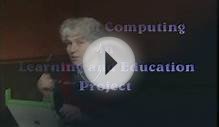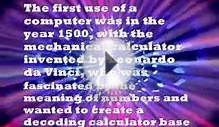![Modern Era[edit]](http://www.comsto.org//img/computers_in_the_classroom_wikipedia.jpg)
The modern computer age is still fairly young. The MARK 1 and ENIAC, the first operational computers, were used in 1944 at Harvard and 1946 at the University of Pennsylvania, respectively. In education, computers were primarily used to gain experience with real world problems in various subjects including: mathematics, science, and engineering.
In 1963, John Kemeny and Thomas Kurtz, employees at Dartmouth, revolutionized the use of computers in education by utilizing them as academic tools. They traded the punch card system as a method of batch processing for the time-sharing system. The time-sharing system was successful enough to create a regional center for local colleges and schools to visit. Kemeny and Kurtz also created a new computer language called BASIC, which replaced FORTRAN. BASIC was soon used for the development of instructional computer programs for all varieties of education.
Timeline
- 1990: Schools begin using videodiscs; object-oriented multimedia authoring tools become popular; Simulations and educational databases are offered on CD-ROM disks
- 1992: Schools begin using Gopher servers for on-line information for students
- 1994: Object-oriented authoring systems grow in popularity in schools; most US classrooms have at least one PC available for instructional delivery, but not all teachers have access to a computer for instructional preparation.
- 1995: The Internet and the world wide web become popular as websites grow in usage
- 1996: The Internet allows for new graphics and multimedia tools to be developed for the delivery of information and instruction; many schools are rewiring for Internet access; a few schools install web servers and provide faculty with a way to create instructional web pages.
- 1997-2007: The Internet expands faster than predicted; Educational software becomes more useful with the use of graphics and video; Larger computer storage capacity allows educators to store large graphic, video, and sound files for educational applications on personal computers using CD-ROM and DVD.
Factors Effecting Education
- Globalization
- Scientific Information Revolution
- Cognitive Science
- Shifting Educational Concerns
Access to education has vastly increased during recent decades. The National Science Foundation (NSF) established policies in the late 1960s to broaden access to computers in America. Three hundred post-secondary institutions and a small number of secondary schools received access to regional computing networks located across the country. From 1963 to 1975, the number of students who had access to computers in American secondary schools rose from 1% to 55%. Over two million students utilized computers in their classes in 1974. By 1975, computers were primarily used for instruction by 23% of students.
Hoping to change the group-oriented pace in computer instruction to a more individualized learning experience, in 1963, Patrick Suppes and Richard Atkinson, Stanford students, created a computer -assisted instruction program for research and development in mathematics and reading. This self-paced instructional tool helped users to correct their responses through speedy trial-and-error activities. Hoping to change the group-oriented pace in computer instruction to a more individualized learning experience, in 1963, Patrick Suppes and Richard Atkinson, Stanford students, created a computer-assisted instruction program for research and development in mathematics and reading. This self-paced instructional tool helped users to correct their responses through speedy trial-and-error activities. Suppes and Atkinson's program allowed student's to adopt a more involved position in their own education.
The need for Micro Worlds
MIT'S Seymour Papert created a new computer language in the early seventies called LOGO. Papert's goal was to influence computer's relationship to education. Unlike other languages, LOGO specifically targeted children and aimed to increase their critical thinking concerning mathematics. LOGO provided children with the opportunity to practice their math skills in a "micro world" setting that included elements like music and physics. Primary education made use of LOGO in the subsequent efforts to increase computer literacy.
As a supporter of the Constructivist approach, Papert viewed learning as a modified version of knowledge. He partnered with the makers of the LEGO construction kits to provide children with an opportunity to detect and solve problems by using inferred practical problem-solving skills through computer-driven LEGO creations. He believed that effective learning resulted in the creation of a significant consequence. Papert has been an instrumental player in the shift away from simply "computer literacy" to "computer fluency."
The Rise of Micro Computers
The personal computer revolution was sparked by an economic shift away from time-shared systems to microcomputers in 1975. Time-shared systems were a cheaper alternative to expensive computers and were purchased by educators who carefully allocated access to the limited resource.
By the late seventies, personal computers were in high demand in the home, office, and of course education. In fact, many schools and universities began requiring students to purchase computers. The need for computers in education arose from the pressure exerted by students, parents, and teachers through the previous years.
INTERESTING VIDEO












